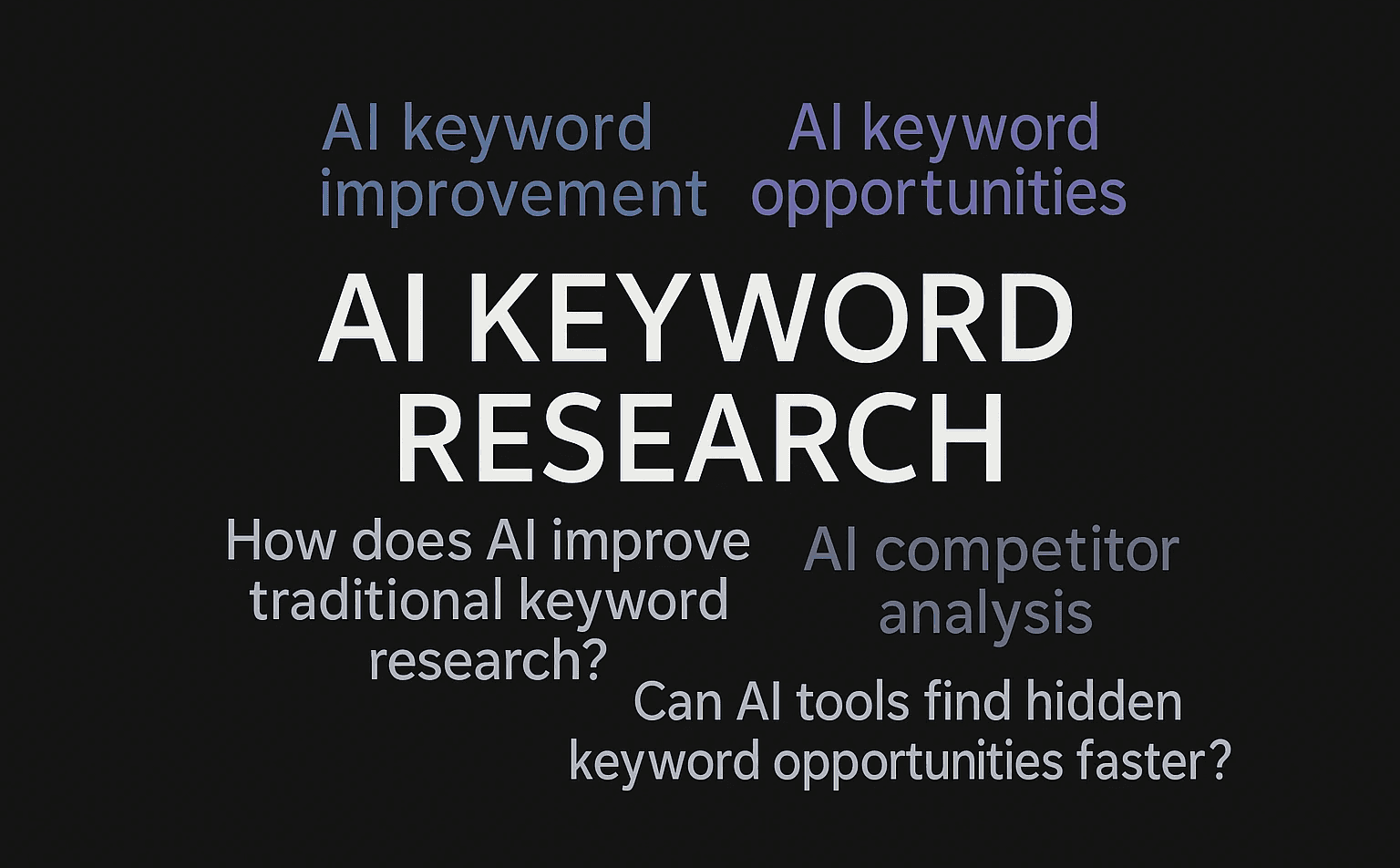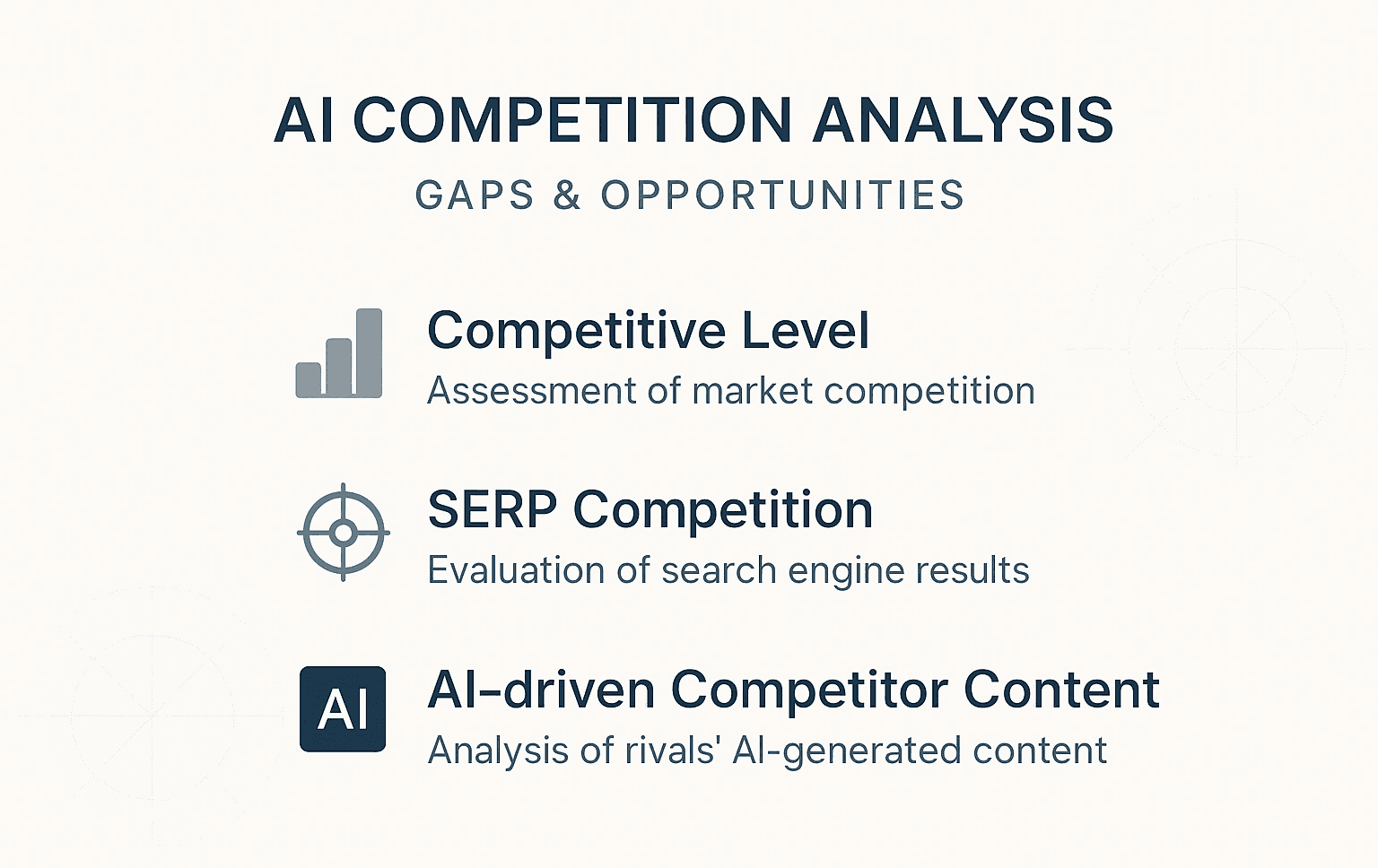AI-Powered Keyword Research
Oct 24, 2025
This article presents a real-world case study alongside a four-step framework for identifying high-intent keywords, evaluating competition, and uncovering content gaps. It also reinforces the continued relevance of keywords in the AI era and explains how AI can support the early stages of content strategy development.
Smarter Keyword Research with AI
Keyword research has always been a cornerstone of SEO, guiding marketers in understanding search intent, prioritizing opportunities, and structuring content around meaningful topics. What’s changing today is not the importance of keywords, but how we discover and apply them. With AI-powered tools transforming both search behavior and content creation, keyword research is evolving from static lists into dynamic, insight-driven strategies.
Let’s explore why keywords still matter and how AI is transforming the way we approach them.
Why Keywords Still Matter in the Age of AI
As more people turn to AI tools for answers instead of traditional search engines, many marketers are asking the same question: Is keyword optimization still worth the effort?
The concern is valid. Studies show that SEO traffic and click-through rates are declining. When Google’s AI Overviews appear in search results, only about 8% of users click through to a traditional listing, compared with ~15% when no summary is shown (Pew Research Center).
Here is the new mandate for keywords:
Discoverability still depends on keywords: Both search engines and Large Language Models (LLMs) use keywords to determine relevance, topic clustering, and source authority for a given query. You must signal your expertise.
SEO Targets All Content Assets: AI-powered answers synthesize information from all indexed sources. This means product pages, support documents, and onboarding flows can all surface inside AI-powered answers.
Optimize for AI-Readability (Clarity & Structure): LLMs preferentially extract and summarize structured content. Prioritize clear, quotable sentences, FAQs, bullet points, tables, and concise introductory summaries.
Precise Targeting is Your Edge: With AI accelerating content creation, a highly specific and focused keyword strategy is essential for brand visibility and differentiation, ensuring your facts are the ones that get cited.
In short: keywords aren’t optional; they remain the foundation of discoverability in both search engines and AI-powered platforms.
Why Traditional Keyword Research is No Longer Enough
For years, keyword research followed a familiar formula:
Start with a seed term
Use a tool to generate variations
Sort by search volume and difficulty
Although once effective, this approach is now too slow, reactive, and fundamentally limited. In today’s AI-driven environment, where users express queries in natural, conversational language and AI assistants deliver contextual, intent-focused responses, static keyword lists are no longer adequate.
How AI Transforms Keyword Research
AI is not just making keyword research faster; it’s making it smarter. Instead of chasing raw lists, we can now use AI to:
Generate natural-language queries that mirror how people type or speak.
Surface search intent and topic relationships to connect content with real audience needs.
Identify semantic clusters that move us beyond single keywords into groups of related terms and concepts.
Spot content gaps with greater precision than traditional tools.
This shift allows SEO professionals to move from keyword hunting to keyword strategy. Instead of just collecting data, AI enables us to uncover patterns, intent, and opportunities that align directly with business goals.
How to Do AI Keyword Research - A Practical Use Case

Let’s make this practical with a real example. We’ll use the topic of this article itself, “AI keyword research” as our seed and walk through how AI expands it into a richer keyword strategy.
Step 1: Define the Initial Stage
Keyword research should not be the very first step. Before an SEO strategist starts pulling keywords, the fundamentals must already be in place. These are typically owned by content leaders and campaign managers, who set the direction of the campaign and define the business goals that SEO should support.
From an SEO perspective, this step matters because without clear fundamentals, keyword research risks focusing on high-volume terms that don’t align with the business aim or persona. When the foundation is strong, keyword insights become much more actionable and ROI-driven.
Content leaders should provide SEO teams with a concise campaign brief that clearly outlines the following criteria:
Main topic: AI keyword research
Purpose of the content: Educate readers on how AI can be used to enhance traditional keyword research workflows
Business aim: Establish authority and thought leadership around the topic at hand, in this case, AI keyword research
Stage in funnel: TOFU: Informational, top funnel
Target persona: SEO professionals looking for a competitive edge with AI tools & Content managers exploring AI-driven research workflows
Step 2: Initial AI SEO Research
Once the fundamentals are clear, this is where the SEO work truly begins. At this stage, we don’t yet know what the article’s subtopics or structure will be. Those decisions will be defined by the keyword opportunities and intent signals uncovered through AI research.
The role of SEO here is to create the foundation for the content brief by:
Identifying the questions people are asking around the topic.
Highlighting high-intent queries that reveal what matters most to the audience.
Extracting short keywords that can later be used in headings, metadata, and keyword clusters.
To support this research, we can use AI prompts to generate structured keyword ideas and uncover search intent efficiently. The following prompt is designed to guide an AI tool to produce relevant, high-quality keyword insights for this topic.
Example AI Prompt
You are an experienced SEO specialist supporting SaaS marketers. Please generate a list of 10 high-intent, long-tail keywords related to "AI keyword research," focusing specifically on question-based phrases that address specific problems. Provide 5 questions for each of two key focus areas. The goal is to educate readers on how AI can enhance traditional keyword research methods. Additionally, include short keywords (two to three words) derived from the questions above. |
The AI Outcome from the prompt:
Focus Area 1: How AI Improves Traditional Keyword Research
Short Keywords (derived): "AI keyword improvement"; "AI keyword opportunities"; "AI competitor analysis"; "AI long-tail keywords"; "AI vs traditional keyword tools". Focus Area 2: Practical Applications of AI in Keyword Strategy
Short Keywords (derived): "AI keyword trends"; "AI keyword clustering"; "AI search intent"; "AI keyword gap analysis"; "AI keyword research SaaS". |
Why was this prompt effective?
The prompt is highly effective because it directly addresses the three core requirements of modern, AI-driven search, moving beyond simple keyword volume.
Shifts keywords to intent: Asking for "why" and "how" questions moves the focus from generic short-tail keywords to highly specific long-tail queries that target informational intent.
Structures keywords into topics: Defining two "Focus Areas" forces the output to be grouped semantically. The keywords are instantly organized into potential Topic Clusters, ensuring comprehensive coverage, a strategic keyword advantage.
Reinforces semantic entities: The derived short keywords reinforce the primary semantic entities for each question. While the content answers the long-tail question, these core keywords ensure the page is optimized for the search engine's Natural Language Processing (NLP) models, boosting relevance across a wider range of related searches.
Step 3: AI Competitive Analysis
Keyword opportunities only become valuable once we understand the competitive landscape. Running AI research without checking competition risks targeting queries that are already saturated with content or, worse, failing to identify gaps where we could win visibility. That’s why AI is essential for speeding up competitive analysis.

Let’s look at the example below.
AI Prompt: Competitive Landscape Analysis
Analyze the current content competition for each generated question. Include the competitive level, what is already out there and gaps/opportunities. |
Outcome:
Question | Competitive Level | What’s Already Out There | Gaps / Opportunity |
How does ai improve traditional keyword research? | Moderate to high | There are several recent “AI vs Traditional” or “How AI helps keyword research” posts. E.g., SuperAGI. Also Epic Web Studios. | Many articles are generic; they list benefits, use-cases, sometimes tool names. What’s less common is concrete before/after case studies, cost vs effort trade-offs, quantitative benchmarks, or comparisons in different niches (e.g. SaaS vs e-commerce vs local). |
Can ai tools find hidden keyword opportunities faster? | Moderate | Some content touches on this (e.g., content about “discovering low-competition keywords” via AI, forecasting, faster clustering) — e.g. SEOBot. Also Keyword Insights. | Might be less saturated if you frame “hidden opportunities” in very specific scenarios, tools, or in SaaS keyword vocab. Demonstrations with screenshots of searching vs AI could help. Also focusing on “faster vs traditional timelines” with data adds value. |
How does ai improve search intent analysis in keyword research? | Moderate | Some content includes “intent signals,” “intent driven keywords,” “semantic understanding,” etc. E.g. Epic Web Studios. Also Nightwatch. | Opportunity: delve into “how to detect intent,” compare types of intent (informational, transactional, navigational), show how AI tools misinterpret intent and how to correct them. SaaS-specific examples (free trials, demos etc.) could help. |
What are the best ways to use ai for keyword gap analysis? | Lower to moderate | There’s some mention of “keyword/gap analysis” but less deep content. Many articles talk generally about competitor keyword coverage and gaps. But not many detailed “AI enabled gap analysis” guides. See Nightwatch. Also Keyword.com. | Good opportunity to write a guide, especially focused on tools, how to gather data (competitor keywords, content mapping), how to prioritize gaps, and how to fill them. Case studies would help. |
How can ai streamline keyword research for saas marketers? | Lower | This is more niche: combining “AI keyword research” + “SaaS marketers” is less common. Many AI-keyword articles are generic or focused on e-commerce, content marketing more broadly. | Strong opportunity. If you build content tailored to SaaS (subscription model, feature-driven content, product-led growth, trial vs demo keywords, etc.), you can fill a less crowded niche. |
*To keep things simple, I’m showing just five of the ten questions here.
This competition analysis gives keyword research critical context:
It reveals saturated queries
It identifies opportunities to compete
It highlights content gaps, such as generic coverage or missing niche use cases
These insights help content teams not only decide what to target, but also how to differentiate and deliver unique value.
Step 4: Turning Research into a Content Brief
The final step is translating keyword and competition insights into a content brief. At this point, SEO delivers the research that defines the landscape: the core terms, supporting clusters, and the high-intent questions that audiences are asking.
This gives the content team the inputs they need to decide:
Which angle best fits the campaign goals
Which questions are most relevant to address
How to position the piece in a way that differentiates it from competitors
In other words, SEO defines the opportunity space, and the content team chooses how to turn that into a compelling article.
Final Thoughts
AI has transformed keyword research into a faster, more strategic process. Tasks that once took hours, such as identifying high-intent queries, analyzing competitors, and drafting content briefs, can now be completed in minutes. Rather than replacing traditional SEO tools, AI enhances and streamlines them, empowering marketers to work more efficiently and make smarter decisions.
Share on LinkedIn




